Best Water Softener & Filter Systems 2017 – Reviews and Comparisons

TOP SHOWERHEADS REVIEWS
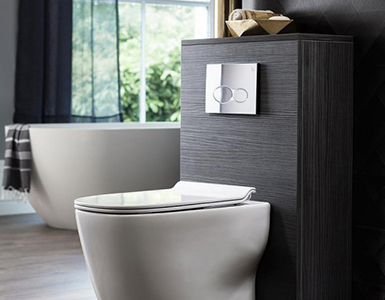
TOP RATED TOILETS REVIEWED
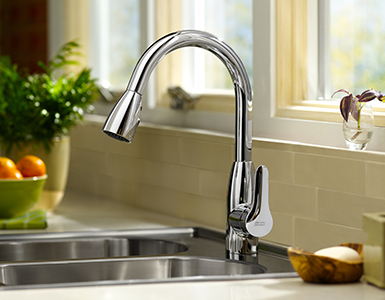
BEST KITCHEN FAUCETS 2017
If you have hard water at your home, it can lead to serious issues. For example, kitchen appliances that work by using water can get their sensitive hardware damaged by it. Scale accumulation is a serious issue if not treated properly and on time. When hard water dries out it leaves a layer of scale behind. Hard minerals like calcium and magnesium do not evaporate but rather stay attached to a particular surface. That’s where water softeners come in handy. Water softeners eliminate hard minerals from the water by using a method called the ion exchange. The benefits are great, and the most important thing is that they’re affordable and available to anyone.
Because there are a lot of water softeners on the market at the moment, it’s important for you to find the perfectly suitable one for yourself. That’s the moment in which we get in and try to help you choose. Speaking of the best water softener, it’s the Fleck 5600SXT, in our opinion. This water softener is manufactured in the UK by a well-known company named Pentar Ltd. It is easy to use, and you can mount and install it by yourself.
However, if you don’t have the required skills, don’t despair, a plumber can mount it within an hour. Bear in mind, this is a recommended product for average sized homes. If you have a bigger home, opt for the Fleck 7000SXT. It is very similar to 5600SXT by performance, but its capacity guarantees good water flow and pressure in bigger facilities. If you, however, opt for a salt-free softener, the best one is the Eddy Electronic Descaler.
QUICK LINKS
- Our top Water Softener system
- Best Water Softener for a small house
- Best Water Softener for a large home
- Best salt-free water softener
- Water softeners and filters from our top list
- Best Water Softeners Comparison Chart
- A Short Guide to Choosing the Best Water Softener
- Know Your Water
- Water Purification Methods and Technology
- Clean Water Benefits
- Top Water Filter & Softener Brands List
- History of Water Quality and Filtration
- Common Water Softener Problems – Troubleshooting
- Maintaining Your Water Softener – How to Keep it Healthy
- Water Softener FAQ
Our top Water Softener system
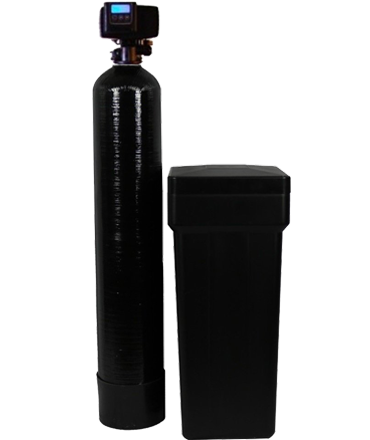
1. Fleck 5600SXT 48,000 Grain Softener
We have chosen the Fleck 5600SXT as the best of the best. It is a complete product and offers everything you want in a quality softener. Installation is easy, and anyone can do it, you don’t need any extensive plumbing knowledge. It comes with a 10-year warranty on the tank and a 5-year warranty on the control head ensuring customer satisfaction. As far as the performance goes, it performs flawlessly. Consuming water will feel safer, and it will taste much better than before with this unit. The best thing about it is that it requires minimal maintenance.
This unit is made by a well-known manufacturer from the UK by the name of Pentair Ltd. They are known as one of the most popular companies in the softeners business, and that’s one of the first indicators of the quality of this particular product. Before purchasing this product make sure you read this review to get a better insight into the features and benefits this product has to offer.
The installation is pretty simple and easy. However, if you have trouble with using tools or with assembling something, feel free to call a plumber. On the other hand, if you decide to do it yourself, that’s fine too, it shouldn’t take more than two hours. Remember to switch off the main valve and cut down the main water supply when you’re installing this unit.
Once you install the system, read the manual thoroughly and start programming the device. There’s no need for panic; programming is simple, and the manual is very user-friendly. The data you’ll need is water hardness, system capacity, and the overall water usage. Programming will be easy if you have these parameters.
This device performs great; that’s why it found the number one place on our list of best softeners. Also, the durability is just impressive. Your drains will remain unclogged for a long time. There will be no more water stains on your bathroom tiles or scale in your plumbing. One of the best things about this is the minimal maintenance requirements. While all the other softeners require quite a lot of maintenance, that’s not the case with the Fleck 5600SXT. As long as you follow the instructions from the manual, you shouldn’t have any problems whatsoever with water quality loss. With its continuous flow rate and 48000 grains capacity, it deserves the number one spot.
Best Water Softener for a small house

2. Nuvo DPMB Manor Salt Water Softener System
The best softener for a small house is the Nuvo DPMB Manor Softener System. It is an innovative and eco-friendly product. It uses citrus to provide the softening solution for hard water. It uses a special process called Chelation which binds to the minerals in the water making them soluble. It’s washable from your tiles, hair, dishes, and appliances this way. This system is recommended for water up to 30 grains of hardness. One of the notable things is the lifetime warranty from the manufacturer, so you don’t have to buy another softener again.
If you find it hard to wash your clothes, dishes or your water comes out with impurities then Nuvo DPBM Manor Salt Water Softener might be the thing you’re looking for. It has a 65000 grains per gallon capacity which means that an average family of six will get a year’s worth of use from this softener. The replacement cartridges are easy to install and easy to change. Unlike other softener systems, this one doesn’t require frequent maintenance. Also, a lot of water softeners require precise programming and fuss, this one does not.
That said, it does require some time to start working properly. It eliminates the hardness from the water instantly, but it also works around on a scale buildup that might exist. It could take up to a year until you notice any changes in the quality of drinking water if a softener hasn’t been used for a while.
Heavy hard water isn’t a good thing for this product. If your home water is as heavy as it gets, you should consider purchasing another softener. You might notice some changes after a few months of use, but the scale will start building up again soon. There is a possibility of frequent filter changes, but a salt softener might be a better solution. One more thing you should pay attention to is the replacement cartridges. These cartridges tend to be expensive in oppose to a bag of salt. If you calculate the monetary difference, you’ll see that having a cartridge system tends to be pricey.
Considering a cartridge costs around sixty dollars, while a bag of salt costs fewer than five dollars, the math is simple. If you don’t have a high particle level in your home water, feel free to purchase this unit. However, if you struggle with water hardness, opt for other water softeners.
Best Water Softener for a large home

3. Fleck 7000SXT Water Softener
The best softener for a large home is the Fleck 7000SXT Water Softener. Fleck is a well-known name in water softeners, and it presents the type of the valve used in the process of water softening. This unit is similar to the5600SXT we mentioned before, but with more capacity and a bigger water flow thus making it perfect for large homes and medium-sized industrial facilities. It provides scale reduction, preservation of the plumbing system, prevents the buildup of minerals, and more.
The maximum flow rate of this unit is about 35 gallons per minute which is more than enough for a bigger home. With 48 thousand grains per gallon, it is capable of working with water that has high amounts of calcium and other minerals that cause scale accumulation in the pipes. It’s easy to install, and you don’t need a vast plumbing knowledge to set it up, program it, and get it running as soon as possible. Also, in case you suddenly lose power, rest assured it would “remember” your settings and apply them after the power loss.
The salt capacity of this unit is around 250 pounds. The consumption depends on the hardness of your water. However, an average period optimal for salt change is around 12 weeks (3 months). One thing that sets this softener apart from others is the ease of installation. While other units require extensive knowledge, installing this one is a piece of cake. It can be done within an hour by an inexperienced individual. However, if you’re unsure of your plumbing skills, it might be better to call a plumber and let a qualified person install your device. If you’re looking for a solid softener with a high water flow, don’t hesitate to buy this one, you won’t regret it.
Best salt-free water softener
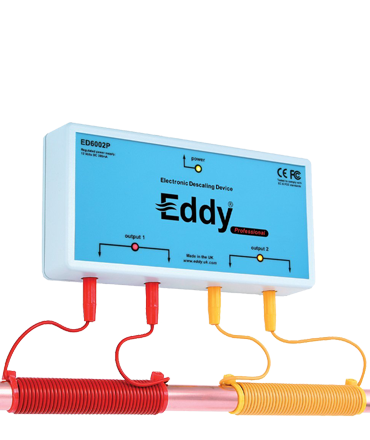
4. Eddy Electronic Water Descaler
The best salt-free softener is the Eddy Electronic Descaler. Although it’s in the softeners group, it’s a water descaler, not a conventional softener. However, this is the best alternative to a softener. Eddy Electronic Descaler is easy to install and use. All you need to do to get it up and running is put two different coils on two pipes and wire up the device. Instead of hassling with complicated and sophisticated equipment you’ll just need to wrap two coils around two pipes, simple as that.
The technology that this unit uses is called a complex magnetic wave. The coils on the pipes emit magnetic frequencies and manage to break down the compounds that turn into scale. This concept means you’re going to reduce the accumulation of scale within the pipes greatly. Bear in mind; this water reducer does not alter the chemical hardness of the water. The reason behind this is that, for example, calcium has been linked with the reduction of heart disease risks. It does not break the chemical elements because of the health benefits.
It is eco-friendly, and it does not require salt. This benefit makes this system an easy and cheap thing to run. Also, because it uses magnetic waves, there are no detrimental effects on the environment. One thing you should bear in mind is the material from which your pipes are made. This unit will work with any materials except iron and lead. It has a 12-month risk-free warranty and a lifetime warranty on repairs and replacements. If you’re looking for a descaler which saves you time, money, and effort, this is a unit worth looking into. It’s not the cheapest on the market, but the cost efficiency levels are high. Instead of buying multiple bad ones, opt for one good quality water descaler.
Water softeners and filters from our top list
There are other valuable and useful units available on the market besides these three from our list. Choosing the right softener can turn out to be a difficult task. You have to include the hardness of the water, the required flow, the size of your home, and more. Instead of lurking around the Internet and looking for the best one, feel free to refer to this list, and you should find the best suiting one for yourself with ease and without much hassle. These six units should offer more than enough features one might need in their home.
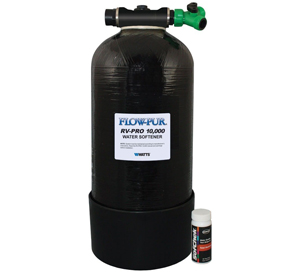
5. Watts RV PRO-1000 Portable Water Softener
This is the best-rated softener for RV’s, campers, and individuals who like to travel. It offers simple installation and ease of use. Previous plumbing knowledge isn’t required as well as frequent maintenance. It’s compact, and it won’t use much space in your RV. Also, this unit works on standard salt, so you don’t have to buy the special salt for softeners. The capacity of this unit is 10000 grains.
It is also a light unit with just 9 pounds of weight which makes it mobile and portable. This unit will eliminate scale and minerals that build up in your water without many problems. As long as you follow the instructions from the manual, you’ll be more than satisfied with this unit. This product got a lot of positive reviews on major merchandiser sites, and it has around 4.5 out of 5 stars, meaning it’s worth every penny.
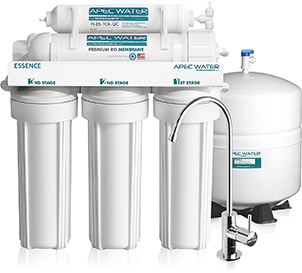
6. APEC Reverse Osmosis Drinking Water Filter System
One of the major pros of this unit is that it can handle and treat any type of water, including hard water, well water, and water with different pH values. This system uses five different stages to decontaminate your water. The first stage is to remove the dust and harmful particles. The second and the third stage eliminate various minerals and chemicals that cause a bad smell or bad taste. The fourth stage is designed to eliminate toxic elements like arsenic, lead, chromium, and more. The last stage removes any waste left in the tank.
This system connects directly to the source. Before installing this particular unit, bear in mind it’s quite large, and it can take a lot of free space. Also, it weighs around 25 pounds, so it’s not light by any means. The good thing about it is that you can install it without the help of a professional.
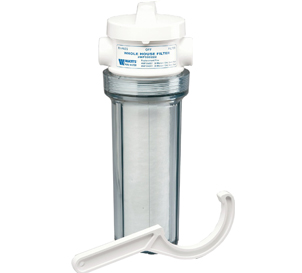
7. Watts WH-LD Premier Whole House Filter System
This unit works great when it comes down to sediment, dirt, and rust removal and elimination. This is an affordable whole house system, and it’s easy to set it up. It comes with three filters and a wrench for installation. Since this unit does not remove chlorine, small sediment, and other harmful particles, it’s recommended to city water only. You will have a cleaner shower, better water, and you’ll prolong the life of your kitchen appliances by a significant amount with this unit.
This unit is a whole house filter system, and it’s slowly becoming a standard across the United States. Most of these systems don’t require a plumber, so the integration of this system into your plumbing system is a piece of cake. This said; many whole house filter systems do need a professional intervention because they’re too complicated for an inexperienced individual. It’s also much safer to hire a plumber instead of doing it yourself.
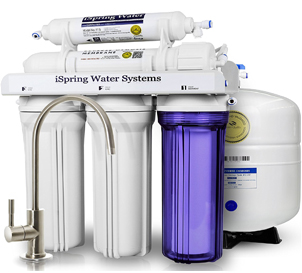
8. iSpring RCC7 Reverse Osmosis Water Filter System
This is one of the systems with the highest capacity, and it produces around 75 gallons of fresh water per day. It’s an efficient system without a pump, and it only uses two gallons to produce a gallon of clean water. This is favorable in comparison to other models which can use up to four gallons to produce a single gallon of clean water. When speaking about efficiency, we can’t help but mention the 98% of efficiency regarding the elimination of heavy metals, chemicals, and other harmful elements found.
The filters are positioned in a clear plastic box on the central manifold. You will get a plastic spanner to loosen up the casing and change the filters. It’s easy to do it, and you don’t need any professional help. Installing it can also be easy if you have some basic DIY skills and you follow the instructions from the manual.

9. On The Go OTG4 – DBLSOFT Portable Water Softener
This is a salt-based, high capacity softener. It is a softener ideal for recreational vehicles, and it features 16000 grains capacity. This unit can produce up to 40% more soft water than any other softener available on the market (with the same capacity). The operating pressure peaks up to 120 psi which is more than enough pressure for a medium-sized RV.
The notable element of this unit is its space-saving and compactness. Space-saving allows you to install it almost anywhere. The installation guide included with the product is easy to read and comprehend thus saving a lot of time, effort, and most importantly – money. The durability is also a significant element within this unit because it can run up to seven years without any downtime (with proper maintenance). This unit is the perfect one-stop solution for hard water and scale accumulation issues in your plumbing.
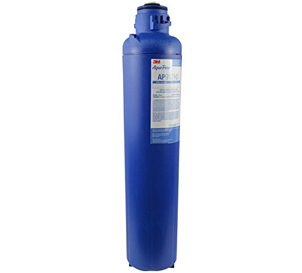
10. 3M Aqua – Model AP917HD Pure Water Filter
This filter reduces chlorine, bad taste, and odor in hard water. It has been rated to 20 gallons per minute flow rate which is more than enough for a small house and small commercial facilities. It doesn’t require any activation and it’s equipped with an O-ring type of seal. It can filter up to one hundred thousand gallons of water which is as much as a year’s supply.
This cartridge also includes a scale inhibition media to prevent further scale buildup in the plumbing. All materials used in the production of this filter are FDA approved and safe. One of the best things about this filter is the ease of installment. The Sanitary Quick Change (SQC) system allows you to change the filter without compromising and polluting the mechanism. It can filter any particles larger than 5 microns which is impressive for a simple and compact filter like this one.
Best Water Softeners Comparison Chart
| PRODUCT IMAGE | PRODUCT NAME | TYPE | CAPACITY | SUITED FOR |
|---|---|---|---|---|
 | Fleck 5600SXT 48,000 Grain Softener | Salt Based | 48.000 grains | Standard Homes |
 | Nuvo DPMB Manor Salt Water Softener System | Salt Free | 65.000 grains | Standard Homes |
 | Fleck 7000SXT Water Softener | Salt Based | 48.000 grains | Large Homes |
 | Eddy Electronic Water Descaler | Magnetic | N/A | Small Homes |
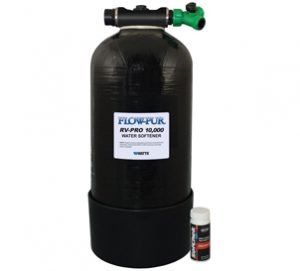 | Watts RV PRO-1000 Portable Water Softener | Portable Salt Based | 10.000 grains | Small Homes |
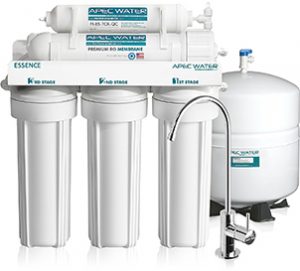 | APEC Reverse Osmosis Drinking Water Filter System | Salt Free | N/A | Large Homes |
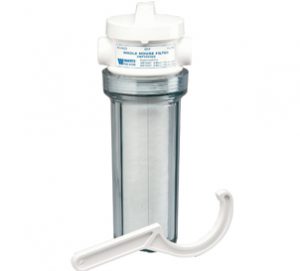 | Watts WH-LD Premier Whole House Filter System | Salt Free | N/A | Whole House |
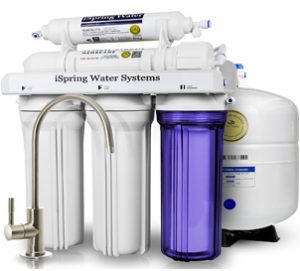 | iSpring RCC7 Reverse Osmosis Water Filter System | Salt Free | N/A | Large Homes |
 | On The Go OTG4 – DBLSOFT Portable Water Softener | Portable Salt Based | 16.000 grains | Small Homes |
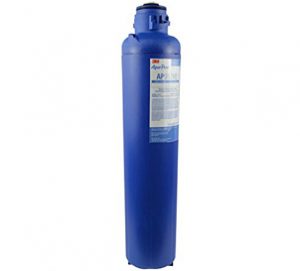 | 3M Aqua – Model AP917HD Pure Water Filter | Salt Free | N/A | Whole House |
A Short Guide to Choosing the Best Water Softener
PORTABLE VS. STANDARD
The first factor you need to determine when purchasing a softener is whether you want a portable or a standard softener. Choosing between these two depends on the size of your home, the hardness of the water, and other elements. If you, for example, want a softener for an RV, portable ones would be the right choice. There are many portable units which use regular salt, are compact, and cost-efficient.
Portable softeners are for smaller plumbing systems and people with low soft water demands. However, being portable doesn’t mean they produce small amounts of soft water. Some provide up to 1600 gallons within 30 minutes.
On the other hand, standard softeners are for people who want to attach a softener onto their plumbing system permanently. These tend to be pricier but better when it comes down to the quantity of soft water, quality, and complexity. Standard softeners are also harder to install.
ELECTRIC VS. NON-ELECTRIC
The difference between these two is that, with electric softeners you control the regeneration of the water while the non-electric does it by the incoming water pressure. The electric softeners offer precise readings of the hardness, reliability, and ability to optimize salt settings.
On the other hand, the non-electric softeners use the pressure to control the unit. Non-electric softeners have a lot of moving and mechanical parts, so they require much more maintenance and care. However, they don’t require a power supply. Also, the non-electric softeners must be kept clean.
Electric softeners are most widely-used ones. They are more precise than the other ones, and they offer auxiliary features in oppose to non-electric which rely on water pressure to measure the use. The benefit of electric softeners is that they don’t waste as much water and salt as the non-electric do. Everything else is pretty similar between these two types.
SINGLE VS. TWIN TANK
There are a few crucial differences between single and twin tank softeners. First of all, single tanks offer soft water on demand while twin tank softeners provide a constant flow of soft water. Single tank softeners have a simple design, and they are easy to use.
However, the twin tank ones are more complex. Twin tank softeners tend to fluctuate in water flow when in regeneration while single tank softeners offer a constant and even flow of water. Single tanks are designed to use granulated salt, while twin tanks use block salt.
When a single tank softener is in the process of regeneration, it only offers hard water. On the other hand, twin tanks offer soft water as well as hard water while in the process of regeneration. Twin tanks softeners have a low softening capacity meaning the softener will frequently work regarding the regeneration process thus compromising the flow and increase tear and wear of the unit.
CONTROLS
There are a few factors you need to pay attention to regarding the controls. Bear in mind to check out what controls the regeneration cycle, how long does it take for one cycle, and the amount of salt and water used for recharging. There are several different methods for controlling the cycles, but we’ll mention the two main ones.
The first method is timer control. Electronic timers automatically recharge the softener at a preset time based on your water demands and consumption. This may not be beneficial if you have unusually large water demands on a particular day. One more common problem is that they waste sodium because they regenerate regardless of the necessity.
The second method is a more sophisticated method called DIR (demand-initiated regeneration). DIR reads when the resin needs to be recharged. DIR saves a lot of salt this way because it doesn’t recharge the unit unless it’s necessary. This is a good method if you’re planning a massive amount of usage.
FEATURES
Softeners are sold in many sizes and shapes. Each one is rated by the number of grains of hardness they can eliminate between two regeneration processes. The minimal conditions you need in a softener is the ability to provide soft water at least for three days between the regenerations. Bear in mind the physical size of a unit doesn’t mean anything here.
The unit’s ability to soften the water is what matters. Be sure to calculate the amount of water usage in your household, and you’ll find the suiting one for yourself. Getting a softener that doesn’t meet the required amount of water demand isn’t going to help you, you’ll just end up wasting money.
The best way to calculate your household demands is to multiply the number of people in your household by 75 ( the average amount of water used by one person per day). After that, multiply the number you got by the number of grains per gallon of hard water (GPM). The result will give you a recommended grain per gallon value you need to look for in softeners.
WARRANTY
Almost every company offers a similar warranty. However, there are some who are ready to offer more. You should pay attention to this because that’s something you will probably need. It’s always better to have a long-lasting warranty on a mechanical product that’s constantly in use. The usual warranty for these units is five to ten years which is more than enough to cover the possible malfunctions.
Because these units tend to be pricey, it’s crucial you find one with good warranty conditions. Also, beware of low-quality manufacturers and always read the small lettering on the warranty papers. Some companies tend to exclude some parts of the unit from the list of parts under warranty. For example, some don’t offer any valve warranty, while others offer ten years on all parts including reverse osmosis tank and faucet. It comes down to personal preference, but we advise buying a product with a long-lasting warranty, even if it’s more expensive than other models. It’s worth every penny, and it pays itself out in the long run.
Know Your Water
What Is Hard Water?
Hard water is rich in various minerals, in oppose to soft water. It is formed when water flows through chunks of limestone and chalk which consist of calcium and magnesium. Even though drinking hard water can have beneficial effects on one’s health, it’s a different story with industrial units, machines, and other. Hard water tends to leave scale when it dries out. The problem with scale is that it jeopardizes the integrity and function of a particular part, for example, a heating unit within a boiler.
The hardness is determined by the concentration of positively charged metal complexes with a charge value bigger than 1+. The fewer ions there are in the water, the softer it is. Calcium and Magnesium enter into the water supply by percolating from minerals and rocks within the aquifer. Hard water poses a serious risk for modern households.
Some of the issues include clogged pipes because of the accumulation of minerals within the pipes, white spots on dishes and the shower, reduced cleaning abilities of detergents, reduced efficiency of water heating units, and more. Testing for hard water isn’t that hard. If you suspect you have hard water and you’re connected to a public supply, call them and just ask if the water is hard or not. If you’re connected to a private supply, collect a sample and feel free to take it to a testing lab.
If you get a positive response in both cases, consider buying a water softener. It’s an efficient way of preserving your appliances as well as drinking and using healthier water. There are three basic types of softeners – automatic, DIR (demand initiated regeneration), and portable solutions. There is a high possibility that you indeed have hard water in your home. Don’t hesitate to install a water softener in that case.
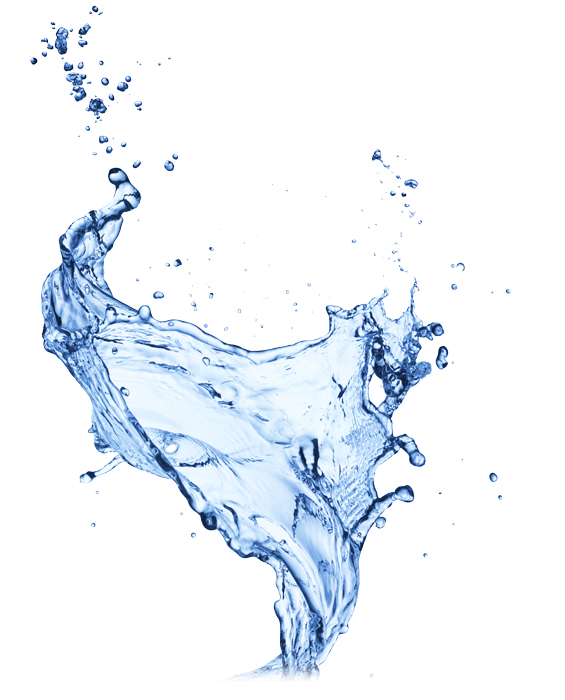
%
OF THE POPULATION HAS HARD WATER
How hard is the Water in Your Area?
It is a well-known fact that the United States has a pretty tough situation with hard water. However, the water softeners market is vast which means there is a solution for this problem. This said, statistics show that 85% of the population has hard water, but only 30% of them use water softeners.
The top six cities with hard water problems in the United States are Indianapolis, Las Vegas, Minneapolis, Phoenix, San Antonio, and Tampa. If you live in any of these cities, you should check out the hardness of your water. Bear in mind; city water may be softer than surrounding suburbs depending on the water source.
Some of the mentionable areas are South Dakota, North Dakota, Minnesota, and Iowa. These are not the states with super-high concentrations of hard water, but they are worth mentioning. On the other hand, Oregon and Washington are the leaders in soft water.
Make sure you pay attention to the hardness and test it as soon as possible to avoid any possible damage to your health, appliances, and water-operated devices in general. Having a water softener will save you a lot of time, and more importantly – money.
%
OF THE POPULATION HAS HARD WATER
How hard is the Water in Your Area?
There is a DIY test for checking out the hardness of your water, and it’s easy to do it. Instead of taking samples to a lab and paying loads of money for analysis, you can do it by yourself. Follow these steps, and you’ll find out if your water is hard without much effort.
Take a clean plastic bottle with a cap
Remove the cap
Fill the bottle about halfway
Add ten drops of detergent
Shake
If it foams up quickly, it’s not hard
If it creates a milk-curd-like film on the surface, that might indicate it’s hard
If you have scale accumulated on your shower door, tiles, mirror, and more, it’s also an indicator of hard water.
There is also an option of sending a water sample for testing to a certified laboratory. Everything above 1 grain of hardness per gallon is considered as hard water. A grain of hardness is an amount of calcium and magnesium equal in weight to a kernel of wheat. Values:
Less than 1 – SOFT
1 – 3.5 – SLIGHTLY HARD
3.5 – 7.0 – MODERATELY HARD
7.0 – 10.0 – HARD
Over 10.5 – VERY HARD
The only successful way to get rid of hard water is by using a water softener. There are other alternatives such as water filters, chemical softeners, mechanical softeners, and magnetic conditioners. There is some lower tech stuff you can do to prevent or clean hard water and scale. First of all, choose a proper laundry detergent. By using cheap detergents, you risk damaging inner heating units within the washing machine. Find a suitable one and use it constantly. The consistency is the main factor here, once you find the perfect detergent – stick to it.
Water Purification Methods and Technology
There are various methods of water purification. Water purification is a process of removing chemicals, contaminants, and gasses from the water. The goal of the whole process is to produce a suitable chemical water structure for various purposes such as medicine, drinking water, pharmacology, and more.
The methods include distillation, sedimentation, and filtration. Purifying water can reduce the concentration of various chemicals, most commonly calcium and magnesium. There is also a method used for reducing parasites, particles, viruses, fungi, bacteria, and more. As for the drinking water standard, it’s usually set by the government or international standards. These standards include minimal amounts of particular elements in water.
Ion exchange is just one of the purification methods. This process removes various metallic elements from the water. This process is also sometimes referred as “water softening, ” and it’s done by utilizing a tank filled with negatively charged resin. As water flows through the tank metallic ions which are positively charged, displace the weakly charged potassium and sodium ions. The metallic ions then stay trapped within the tank thanks to the electromagnetic attraction. This process also removes various harmful metals like lead, iron, mercury, and more. It is crucial to remove the metals at the beginning of the process because it can damage the sensitive elements later on.
Most popular water softeners have automatic regenerating systems. The simplest ones have an electric timer that recharges the system on a regular basis. However, if you have a single tank softener, soft water isn’t available during regeneration. There’s another type of softeners which uses software that records how much water has been used. When it hits a particular limit, the computer begins the process of regeneration. Also, the third type uses a water meter to measure the usage and pressure and induce recharging.
Chlorine Water Treatment
Adding Chlorine to water is used to exterminate particular bacteria and microbes. Chlorination is also used for disease prevention such as dysentery, cholera, typhoid, and more. When chlorine dissolves in water, it converts to two mixtures, hypochlorous acid, and hydrochloric acid. Chlorine is efficient in killing certain bacteria because it’s highly toxic.
This method is one of the oldest for water purification, and it proved to be among the most efficient ones. However, due to chlorine’s high toxicity, there is a great risk of contamination. That said, if used properly, chlorine is one of the good ways to purify hard water.
Cloudy Water Treatment
Two common things cause cloud water. In most cases, it’s various particles and air bubbles. In more unusual cases the cause can be methane gas.
Air bubbles usually form in well-water, and they are caused by pumping. Air bubbles happen most often in cold weather when air particles mix up with the water. Also, lack of pressure can cause air bubbles (also known as white water). It is harmless, and the best thing to do is wait for it to settle down. Particles, on the other hand, must be removed with a sediment filter.
Water Staining Solutions
The best method of removing stains is with vinegar. It’s cheap, available, and it’s easy to make the right solution. All you need to do is make a 50/50 solution with water, pour it into a spray bottle, apply one the stains, and wipe. Anyone can do it with little money and some effort.
However, remember to use regular vinegar. Other types of vinegar like apple cider vinegar just won’t do the trick. You can also prevent staining by wiping wet surfaces, for example, after a shower. If you manage to wipe the water before it dries, it won’t leave a stain.
Clean Water Benefits
Even though hard water isn’t a major threat to your health condition, it’s always better to have clean water. However, the health factor is the least of your worries with hard water and scale residues. The first benefit of clean water is that it doesn’t leave stains on mirrors, tiles, shower cabins, and other smooth surfaces. Clean water is well-known for its ability to reduce headaches, help with mental alertness, regulate body temperature, and more. Clean water also regulates the pH values within your body thus supporting many physiological processes. Staying hydrated is the most important thing because water is a crucial element for every human being.
Serious dehydration causes multiple health problems like diabetes, fatigue, loss of energy, high blood pressure, and more. Make sure you always drink transparent, odorless, and tasteless water. Any other (except for commercial ones) water with a particular taste or smell is polluted and not safe. Water also helps various organs in your body to maintain an optimal level of performance. For example, if you don’t hydrate your body enough with clean water, you have an increased chance of getting a kidney stone. There are also financial, environmental, and contextual benefits.
FINANCIALLY
The first financial benefit is the reduction of washing detergent. Some researches show you’ll save up to 50% by using clean water. Clean water also prevents scale from accumulating within the pipes and kitchen appliances. Scale buildup can damage your kitchen appliances as well as clog your plumbing. You will also save a lot of money on various utilities since the vast majority of appliances perform much better while using clean water. All of these elements affect the overall financial benefit. By preserving your kitchen appliances as well as units like washing machines and boilers, you’ll save a lot of money and unnecessary stress.
ENVIRONMENTALLY
Saving the environment is all about saving energy. Something like a gas-powered water heater can use up to 30% less energy when operating with clean water. By using less energy, it also affects the pollution reduction on a bigger scale. Furthermore, water heaters without tanks use up to 10% less energy with clean water. And the last but not least, the carbon emission is reduced by combining all of these elements. Our planet is in a tight spot for decades, by contributing to the reduction of CO2 you’re also saving the planet.
CONTEXTUALLY
The practical benefits are also vast with clean water. For example, you will reduce the chlorine taste and odor from drinking water. Water stains are a big part of hard water and possibly the most annoying side-effect. Well, you’ll eliminate the stain advent by using clean water. Also, your laundry will come out cleaner, softer, and brighter. Overall, using clean water will increase the performance of your household appliances by at least 20%. That is more than enough to persuade you to make a transition and to start using clean water. It may not have immediate effects, but it’s the best solution for the long run.
Top Water Filter & Softener Brands List
FLECK
Fleck has been on the market for over 50 years, and it is one of the oldest brands. It is the top recommended brand on the market at the moment. The fact that Fleck influenced the development and improvement of water treatments make it the most reliable brand available at the moment. As a company, it has the best ratings on all major merchandise-selling websites. Choosing this brand will solve most of your dilemmas.
Waterboss
Waterboss is a well-known company on the water softener market. They manufacture water softening systems with the concept of water waste reduction. Their products always get high ratings on trusted websites, and that makes them the second-best brand on our list. Because of the long experience in the water softening improvements, Waterboss stands near Fleck when it comes down to the quality of manufacture.

Morton
Morton is best known because of their salt products. They have been in the salt business over 160 years. Among the vast variety of salt products they also have a few water softeners available. Morton has a good reputation for being a reliable brand, especially in North America. Following that logic, their water softeners tend to be good quality units. A vast majority of buyers and clients left positive grades on major selling websites.
Aquasana
Aquasana is best-known for their environmental concerns. Every product they produce is eco-friendly and safe for the environment. They have been on the market for a while now and have proved their quality through millions of sold units. The units are manufactured with minimal waste recyclable parts.
Culligan
Culligan is also a well-known manufacturer of water treatment. They are on the market for over 75 years with proves their quality and devotion to improving and innovating new things constantly. They are also known for following the modern technology and producing modern designs and concepts. The range of their water treatment products is wide and vast. Choosing this brand will assure good quality, reliability, and durability.
WHAT IS A WATER SOFTENER?
A water softener is a device that uses a system of ion exchange to extract minerals from the water. The hard minerals such as calcium and magnesium are eliminated from the water with this process. There are many benefits of eliminating hard minerals from the water such as preservation of kitchen appliances that use water, elimination of scale, and more.
Hard minerals found in water can cause severe damage to your kitchen appliances, washing machines, and any other product that uses water in the operational process. Minerals cause scale buildup; the detergents lose the ability to lather, damages to your hair and clothes, and dry stains on tiles and mirrors.
Usually, water softeners have two tanks – a water tank and a brine tank. One of these tanks consists of resin beads which have a different electrical charge in oppose to hard minerals. The ion exchange process eliminates hard mineral by exchanging them with soft minerals such as sodium and potassium chloride. These soft minerals are regularly added to the softener to help the regeneration process.
Water softeners have been present for decades on the market, and they’ve seen a lot of improvements over the years. Modern softeners are compact, easy to install, and easy to use. Living in a household with hard water can be a burden, and it’s easily solvable with a simple device. Before buying a water softener make sure you thoroughly investigate your water consumption, needs, and budget.

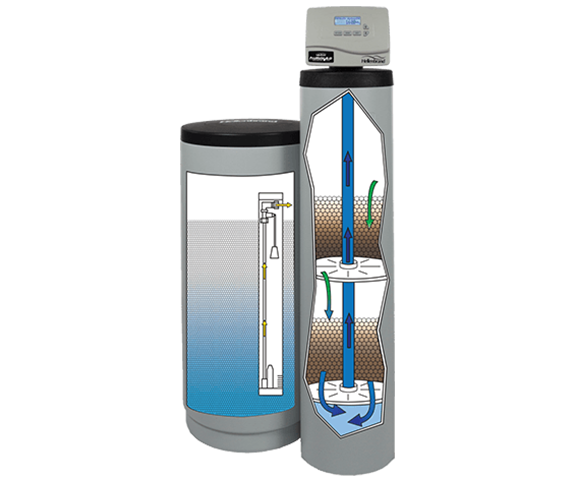
Buying a bigger softener than the one you need won’t improve the quality of the water, you will be left with an overpaid product. That said, you should also be careful not to purchase a smaller softener as well. It won’t be able to meet your demands, and you’ll be left with a product that can’t follow the required capacity and demands.
One of the most notable things about water softeners is the cost-efficiency. People often get underwhelmed by pricey products without considering the efficiency. Although water softeners can be expensive, they are worth every penny in the long run. If you calculate the benefits of water softeners, it will be easier for you to comprehend the value of them. For example, you could use your washing machine twice as long with a water softener installed. By eliminating minerals that cause scale and residues, you’ll preserve the heating unit within the washing machine thus avoiding a purchase of a new one. The principle is simple – it saves expensive and sensitive hardware from potential hazards such as scale accumulation.
By owning a quality softener, you’ll prevent many other expenses. Also, the plumbing will remain clean and smooth instead of being filled up with scale and clogged. As you can see, the prevention is the main parameter with water softeners. Although the results may not be as obvious as you might think, there are some major benefits regardless of the visibility of results. Instead of spending thousands upon thousands of dollars for repairs and renovation, opt for a water softener and avoid massive expenses.

Why Do I Need A Water Softener?
The first step of finding out whether or not you need a water softener is testing your home water for hardness. There are a few ways of testing, but the most reliable one is through the test kits available on the market. However, if you don’t want to buy a test kit, you can check for hardness in many ways. One of the ways is checking out if the soap foams up as it should. The inability of the soap to produce foam is a good indicator of hard water. After you determine that your water is in fact hard, you should consider buying a water softener for following reasons. The first reason to buy a softener is the preservation of kitchen appliances and sensitive hardware in your house. Hard minerals such as calcium and magnesium that are found in water have a negative effect on sensitive instruments because they leave scale and residue after the water dries out. The scale accumulates and acts like a layer of isolation thus preventing the heating units found inside kitchen appliances to work properly. Instead, you get high power consumption because the heating unit tries to achieve the desired temperature regardless.
Before opting for a water softener, make sure you know how hard is your water to avoid buying a weaker softener. If you buy a product that’s not going to be able to solve the amount of hardness in the water, you’ve wasted money.
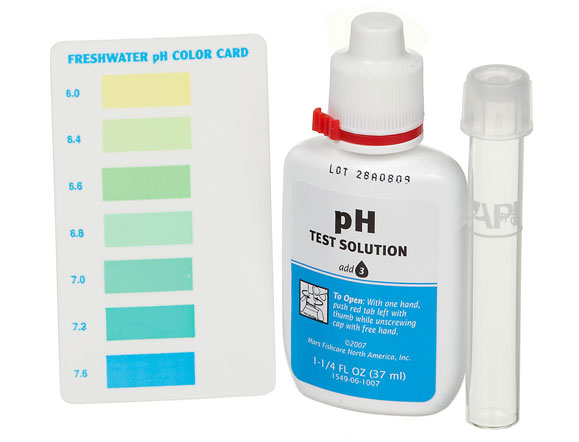

There are many different variations of water softeners, and you should consider investigating each to fine-tune your needs. When you narrow down the choice of water softener’s abilities, it won’t be hard to choose a particular one for your household. The hardest part of the process is finding a suitable one, once you do; everything else will be a piece of cake.
Many people argue about health benefits of soft water. The majority of scientists say there are no major health hazards when it comes down to hard water consumption. However, the main focus drops on the word “major.” In other words, no one absolutely agrees whether or not hard minerals cause any severe damage to the human body. This said, having a water softener installed in your household cannot harm you but not having it potentially can. So, the philosophy is simple – why wouldn’t you buy one and simply play with a safe card? It is not mandatory, but it’s strongly advised.
One of the notable benefits is the elimination of stains. Homemakers, restaurants, bars, and other objects that use cutlery often have issues with scale residues and stains on glasses, silverware, and other. Any smooth glass surface will suffer from stains if the water is hard, including mirrors. To avoid exhausting and endless polishing of glass surfaces in your home simply buy a water softener. Although this benefit doesn’t save money, it surely saves a lot of effort and stress.

How Do Water Softeners Work?
Water softeners work on a pretty simple principle. They use a process called ion exchange to separate and eliminate hard minerals in the water. Usually, there are two tanks inside a water softener. One tank holds salt and brine while the other holds polystyrene beads also known as resin beads or zeolite. Water flows through the first tank (resin tank) and positively charged elements are separated and drawn to the negatively charged polystyrene beads. In this process, the minerals become attached to the beads while water takes on sodium ions.
The product of this process is water that contains salt instead of hard minerals. Salt water does not leave stains nor does it accumulate scale in your plumbing system because there are no hard minerals like calcium and magnesium. It is by far the most efficient way to eliminate hardness from water. The brine water is drained from the resin tank, then thoroughly rinsed and soft water production begins again.
After a while, the beads become full of hard minerals, and they need to be readjusted through the regeneration process. During the process, the water supply to your house will be terminated. A vast majority of modern softeners do this at night to prevent water shortages during the day. While the process lasts the liquid in the brine tank flows back to the resin tank and sodium attaches to the resin beads. This whole process eliminates the hard minerals and cleans the beads. The minerals then get flushed through a drain.
There are some downsides of using a salt water softener, however. It tends to drain power thus increasing the overall power consumption and bills. The second drawback is that you need to have a drain for waste water. The third con is periodical salt changing. You have to buy packs of salt and fill the tank. Because it adds salt to the water, it may be an issue for people on low sodium diets or intolerant people as well. People who grow flowers avoid it as well because it can be adverse for the plants. Also, some people just don’t like the “slippery” feel of the water that contains salt.
There are also magnetic water softeners that work on another principle by using current and electromagnetic energy to separate the hard minerals from the water. They tend to be easy to install and easy to use. Installation requires putting two coils around the plumbing and that’s it. They are less popular than other ones because they are not conventional water softeners but rather descalers. They are suitable for smaller houses and smaller water demands. Because of their compact size, you can fit them anywhere in the kitchen, even under the kitchen sink.
The whole process is simple, and it doesn’t get in the way in any sense. All you need to do when it comes down to maintenance is to change the salt when it’s due. These things are made to last for decades, so durability is also guaranteed.

What Size Water Softener and Filter Do I Need?
There are several factors you need to pay attention to when choosing the size of the water softener. First of all, you need to what are you using it for, how often you will be using it, the size of your family and people who will use the water system, and how often the device enters the regeneration process.

Portable Water Softener
If you want a softener for a smaller object like an RV or a mobile home, you might consider buying a softener made specifically for portability and mobility. The market is full of water softeners that are portable and suitable for recreational vehicles. They are small enough to be carried around and not pose as a nuisance, yet large enough to provide water for the whole household.

Water Filter System
On the other hand, if you just want to soften the water in your home, you might consider softeners with filters that need to be replaced every several months. These softeners are recommended for people who don’t want to alter their water system or mess with their plumbing. They are easy to use, you just have to pour the water and wait for it to pass through the filter.

Whole House Filter System
If you want to soften the water in the entire system, you will need to install one of these systems. The thing about these softeners is that they require a lot of salt to regenerate often enough for daily water requirements. Although it’s not a major drawback, it doesn’t help with the money-saving either. When you determine the size, brand, and type of the water softener, buying one will be as easy as it gets. After that, you only need to setup your budget and fine-tune your requirements.
Types of Water Softeners
All the conventional water softeners use either sodium or potassium chloride. Whether you choose one or the other, it all comes down to personal preferences. Each one has its pros and flaws. However, people most often use sodium chloride. Other than standard units, there are magnetic softeners, salt-free softeners, and electronic softeners. If you want a compact system with as less hassle as possible, opt for electronic or magnetic systems. You cannot miss with your choice because everything is pretty clear and straightforward. In addition to these water softener types, there are some that offer iron elimination as well. These softeners help people who have dry skin or damaged hair. It also helps with laundry.

Salt-free Softener
The salt-free system only descales the water although they are referred as water softeners. For eliminating hard minerals, this system uses template assisted crystallization, also known as TAC. As a consequence of the crystallization, the minerals don’t stick to each other and don’t damage the plumbing. This method may not help much with softening the water, but it will help with the preservation of pipes and sensitive hardware found in appliances.

Electronic Softener
Electronic softeners have wires that are wrapped around the pipes and operate by changing the polarization of hard minerals like calcium and magnesium. Same as with salt-free softeners these systems don’t soften the water and the hard minerals are not completely removed. This system acts only as a preventive method from clogging the pipes and damaging the appliances.
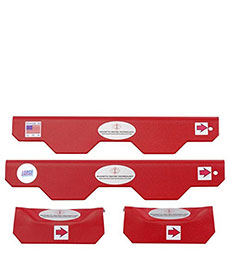
Magnetic Softener
The magnetic water softeners have a similar technique as electronic softeners. You get two coils that need to be wrapped around the plumbing. By changing the charge of hard mineral’s ions, they prevent damage to appliances and clogging the whole system.
History of Water Quality and Filtration
Water is essential for every human being. Water also takes up to 70 percent of the overall size of our planet. Needless to say, water is mandatory for every living creature. However, water can also be detrimental, especially when it’s polluted and not kept drinkable. Because it’s so important to keep it clean and drinkable, humanity has been struggling with the ideas and methods of purifying water and making it drinkable and safe. Some archeological evidence shows that people have been trying to find the perfect method for millenniums.
In the early times of humanity, people associated taste with purity and cleanliness. That’s why they added various herbs and spice to improve the taste and make it pleasing and drinkable. However, we now know that had nothing to do with cleaning the water from harmful elements. There are also indications that people used boiling as a method of purification somewhere around 2000 B.C. A well-known Greek doctor by the name of Hippocrates comprehended that boiling water does not remove residue and solids, so he poured it through a piece of cloth. That is the earliest evidence of ancient filters. It happened in the 3rd century B.C. This method got a name Hippocrates’s sleeve.
 In the 17th century a man named Sir Francis Bacon read about purifying water with sand. He arranged ten experiments and tested this method after he saw its success with sea water. By the end of the 17th century, an Italian physician wrote about multiple layer sand filtrations. This system included three sand filters with the upward and downward flow. After these crucial discoveries, sand filters, and cisterns for rainwater were developed.
In the 17th century a man named Sir Francis Bacon read about purifying water with sand. He arranged ten experiments and tested this method after he saw its success with sea water. By the end of the 17th century, an Italian physician wrote about multiple layer sand filtrations. This system included three sand filters with the upward and downward flow. After these crucial discoveries, sand filters, and cisterns for rainwater were developed.
A French scientist by the name of La Hire had an idea at the beginning of the 18th century that all households should own a sand filter and a rainwater cistern. One century later a first civil water treatment facility was built in Scotland.
In the 20th and 21st century, cleanliness of the water became a major concern. With the industrial revolution and modern technology came much better filters and water softening systems. Chlorine was first acknowledged as useful by Jon Snow when he used it to clean the cholera contamination in London. Recognizing the usefulness of chlorine with the cholera issue, the British government issued an order to start purifying city water with chlorine. This sudden change brought impressive results including fewer deaths from typhoid as well. It was a major success, and the United States started using the same method soon after. It started with New Jersey and soon spread throughout the country.
As years went by in the 20th century, more and more countries started using chlorine as a primary element for water purification. Many countries have recognized the value of treatment plants and started building them. By the mid-20th century, there were multiple laws regulating this matter. However, despite the massive improvement in technology and general knowledge about the matter, water issued from home taps is still pretty contaminated. Even though city plants try to clean the water as much as possible, it still gets contaminated when flowing through lead pipes, and it picks up other chemicals along the way as well. By the time it comes to your home, it’s already polluted again. So, the problem isn’t in the plants; the problem is in the plumbing system.
Throughout the years, scientists have been finding more and more contaminants in the water that pose a threat to your health. Because of the constant pollution of the water and a physical need for fresh and clean water, scientists have developed a filtering system. Water filtration is one of the reliable alternatives.
 One of the crucial breaking points in the development of the water cleaning systems is the invention of the microscope. They are seemingly unrelated, but in reality, the discovery of the microscope helped the research abilities. This happened in the 17th century, and it was done by Anton van Leeuwenhoek. In the 18th century, a Scottish engineer by the name of Robert Thom designed the first water plant. His massive plant was able to provide clean water to the whole city of Paisley in Scotland. This achievement helped to prove scientific evidence about the decrease of waterborne diseases such as cholera or typhoid. In 1852 they passed the Metropolis Water Act that required all water coming to London to be filtrated by the slow sand method.
One of the crucial breaking points in the development of the water cleaning systems is the invention of the microscope. They are seemingly unrelated, but in reality, the discovery of the microscope helped the research abilities. This happened in the 17th century, and it was done by Anton van Leeuwenhoek. In the 18th century, a Scottish engineer by the name of Robert Thom designed the first water plant. His massive plant was able to provide clean water to the whole city of Paisley in Scotland. This achievement helped to prove scientific evidence about the decrease of waterborne diseases such as cholera or typhoid. In 1852 they passed the Metropolis Water Act that required all water coming to London to be filtrated by the slow sand method.
There is a rising concern about the negative effects of chlorine such as the creation of the toxic gas chloroform. Chlorine can react with the natural elements found in water and form THM which is a byproduct of the reaction. Chloroform is detrimental to your respiratory system, and it can cause severe issues and consequences.
Common Water Softener Problems – Troubleshooting
Water softeners as any other mechanical device can experience some issues in their lifetime. These are some potential issues you might stumble upon.
Potential blockage
Because the salt is constantly flowing through the pipes along with the hard minerals, it’s possible for them to start accumulating after a while and create deposits. Those deposits stand in the way and block the flow through the tank. The most common places for blockage occurrence are in the brine line or the filter.
A common sign of blockage is the discrepancy in the softened water. As soon as you notice any difference whatsoever, make sure to check the pipes for clogs.
Luckily, this is not a major problem and it’s solvable with ease. All you have to do is turn off the whole water system and tap the surface until the accumulated salt drops off the wall. Then just pick it up and throw it away. It’s simple yet effective. Although it’s easy to do, don’t prolong the intervention. The more you wait, the greater the risk. Reduced water flow and decreased softening can cause severe damage to your kitchen appliances, health, and to the softener as well. So, as soon as you notice some inconsistency – react right away. It’s always better to prevent something instead of fixing it when it’s already damaged.
Salt crust
Sodium has a tendency to create an alluvium of salt on the bottom of the tank thus forming a thick crust. This crust acts as a barrier between the salt and the water. Several known factors can cause a crust to form. First of all, you might be using a wrong type of salt. Be sure to check the required type of salt for your particular softener and use that type exclusively to avoid crust forming. High humidity in the object where the softener is installed can also induce crust forming within the tank.
This process prevents the regenerating process from happening, and that’s what makes the softener to underperform. If you become aware of any major changes in the softening of the water, the chances are high that the salt bridge is the cause.
Like the blockage mentioned above, this problem is easily solvable as well. Instead of hiring professionals and wasting money, you can do it yourself. All you have to do is pick an object like a stick and put an end to the crust. Pick up all the residues that fall off and clean the unit. Make sure you leave nothing behind because you can jeopardize the mechanism if you leave pieces behind.
Malfunction of the motor
Like any other mechanical appliance, water softener has a motor inside the casing. The motor is the most crucial part of these units; it’s the heart of the softener. If your device fails to start, chances are it’s because of motor failure. However, be sure to check if all the cables are connected, and there’s nothing pulled out. There are many different reasons why motors fail to start or to keep up the pace.
The sad part is that it’s not easily solvable as the previous two problems were. Because it’s a crucial part of the unit, it’s also the most complicated one. If you’re not a trained expert or an engineer, chances are you won’t be able to fix it yourself. So, once the motor dies, prepare your wallet and get ready to call a professional. You are in luck if it turns out as a fixable error, however, if it requires a change that’s going to be pricey. Also, many manufacturers have their technicians who will come to your home and try to fix the problem. Bear in mind, if you try to alter any parts or mess with the inner parts of the motor, you lose every right for a warranty, so it’s best you just wait for the professional.
Polystyrene beads not working properly
Resin beads are only found in salt-based softeners. For the most time, they last for a very long time. However, there is a chance of a malfunction and breaking. The best part about this issue is that it’s easily determinable. If your resin beads start breaking, you’ll see them in your glass of water. If you stumble upon any particles in the water, that’s a good indicator of resin beads breaking. Also, if you notice that your system need more time than usual to recharge, check the resin beads.
Although this step is easily solvable, it’s not painless by any means. There are two possible solutions for this problem. The first one is that you can try to clean them. The success depends on how badly damaged they are. If they are, in fact, damaged heavily, you might opt for absolute replacement. Before doing anything, of course, refer to the manual.
Human error
Every water softener requires some fine tuning and inputting some basic settings and parameters. Because it’s done manually by users, it’s one of the most common reasons for a malfunction. A vast majority of water softeners are straightforward, and almost anyone can use them. But, some of the cutting-edge ones require certain tech knowledge. However, this error is easily preventable by thoroughly reading the manual. If you follow the instructions given in the manual, you’ll greatly reduce the risk of human error.
If you still end up with a user error, check the manual for troubleshooting. User manuals are well-written nowadays, and they offer a lot of potential solutions. Every major company’s goal is to have as little interventions as possible to preserve a good reputation for being a top-quality manufacturer. Most of the manuals are also illustrated, so even if you’re not familiar with the terminology or you find it difficult to understand certain steps, you can always look at the pictures and do it that way. Also, to prevent any possible user errors, don’t experiment with the features. If you don’t know anything about a certain feature, refer to the manual again.
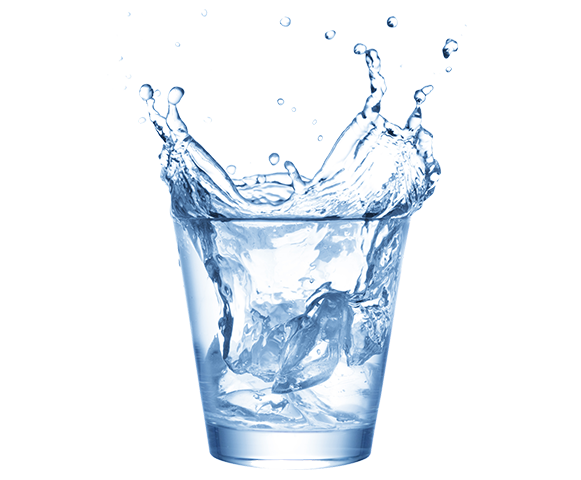
Maintaining Your Water Softener – How to Keep it Healthy
Although most water softeners don’t require much maintenance, it’s always good to check them out from time to time. You’ll find some answers to the most common questions below.
What are the salt level requirements of my water softener?
The optimal level varies for each water softener. The main factor is the water usage. So, as we said, before purchasing a water softener, make sure you make proper calculations and fine-tune the size of the softener with your needs and requirements. By some universal standards, an average household should use about ten pounds per week. As we said, the values vary, and proper calculations are crucial for success.
How frequently do I put salt in my softener?
Salt is a crucial component used for the whole process. Whether your system uses chloride or potassium, it will require regular salt refills for the process of regeneration. If you have any dilemmas considering the question how much salt you need to add, these are some factors that might help.
The size of the tank
The hardness of the water in your area
The number of people consuming the water
Household water utilization
The math is pretty simple with these factors. If you have a larger family – you’ll need more salt. If you have a lot of big appliances that consume a lot of water – you’ll need more salt. Luckily, most of the modern water softeners have an automated system which tells you exactly when to add more salt. By having particular panels doing the calculations, you also avoid the possibility of human error. However, make sure you follow the suggestions and the readings without tweaking it by free will. People make a common mistake of adding more salt than needed thinking that will somehow improve the performance of their water softener. It won’t.
What’s the optimal level of salt in the brine tank?
The brine tank must be quarter-full at all times. That said, for optimal the performance keep the level of salt more than six inches below the top.
You should bear in mind that the salt level is supposed to be above the water level for a few inches. Before you decide to add more salt to the tank, be sure that there is no crust formed on the bottom or the walls of the tank. If you find accumulated crust, just break it with a stick or a particular tool and clean it up. If you find it difficult to remove, try pouring hot water over it.
What is the optimal level of water in the brine tank?
The brine tank also contains small amounts of water; it’s not an alarming fact. However, the level should never be above twelve inches of height.

Some other practical tips
- Make sure to use salt pellets with iron remover. Even though the conventional salt rock is less expensive, it can cause severe problems in the future. The biggest danger is that it can create an accumulation of sediment in the brine tank. Furthermore, it can choke the control valve and the injector.
- Refill the tank only when it’s almost empty. When refilling the tank, make sure you don’t fill it more than two-thirds of its total capacity.
- Iron-Out is a product that thrives in rust and stain removing. It is also perfect for preventive maintenance and cleaning the resin bed and the control valve. Although water softeners don’t demand much maintenance, you should clean them at least once a year with Iron-Out. However, it doesn’t need to be this particular product. Any strong abrasive will do the trick.
- Because the brine tank tends to collect a lot of contaminants during the cleaning process, it’s advised to clean the tank at least once a year. The optimal preventive maintenance is once per six months, but doing it once a year is fine as well. However, remember to stay consistent with your routine.
Applying this advice will help you prolong the lifetime of your unit. By following this information you can save up a lot of money, time, and most importantly – effort.
Water Softener FAQ
Q: How long does a water softener last?
A: A quality water softener usually lasts for a lifetime. However, like any other mechanical unit, it requires some particular measures to stay in operative condition. Preventive maintenance is one of those measures. Even though these devices don’t require extensive maintenance, they still require a certain amount of it. The good news is that it’s not hard and anyone can do it. It also doesn’t require any previous knowledge. Maintaining a water softener is cheap. All you need is a good detergent or a strong abrasive. Also, make sure you check the valves and mechanical parts frequently.
Q: Why is water softening applied?
A: Water softening is applied for various reasons. First of all, the elimination of hard minerals eliminates the occurrence of scale. Scale accumulation can cause some severe damage to your kitchen appliances and devices that use internal heating units. Once the water dries, microscopic mineral residue stays attached on the surface of the heating unit. Once it piles up, it prevents the heating unit from heating the water up thus consuming much more power without efficiency. It’s also useful for people with dry skin, damaged hair, and on low-mineral diets. It prevents scale stains on the mirrors, tiles, and glass surfaces.
Q: What does softened water taste like?
A: Everyone has different taste receptors, so we all have slightly different taste feels. However, many people have said that softened water tastes exactly as it should – pure and clean. Other people have described the taste as metallic and flat. There is a third group of people that can’t distinguish the difference between softened water and hard water. So, in conclusion, it’s all relative and subjective. For example, cooking with soft water will leave vegetables brighter and more appealing to the eye. Also, the best way to describe the taste of softened water to someone who never tried it is – it feels smooth on your tongue if you hold it in your mouth.
Q: Is softened water safe to drink?
A: Yes. Softened water is one hundred percent safe to drink. In fact, it’s much safer and healthier than hard water. However, it is only safe and harmless when it’s processed under strict regulations of sodium levels. Sodium can be extremely adverse for your organism if consumed in excessive amounts. Therefore, if the level of sodium exceeds 200mg/l, it is considered unsafe. That is why many laws and water regulations forbid higher levels of sodium, so it’s a very rare occurrence to stumble upon the unsafe softened water.
Q: Will the water softener make water safe to drink?
A: Yes, it will. Water softeners are designed to make your water safer than unprocessed water. By using special processes, it removes the contaminants, impurities, hard minerals, and harmful chemicals from hard water. However, this doesn’t mean you’re going to drink the best glass of water ever. Some people just don’t like the peculiar taste it gets when hard minerals get extracted. Many people prefer distilled water over softened. Some people exclusively drink bottled water sold in stores. In the end, it all comes down to personal preferences. One thing remains the same – softened water is usually absolutely safe to drink.
Q: Can waste from a water softener be discharged directly in the garden?
A: Although it’s possible, it’s not advised because the brine from the tank disrupts the osmotic pressure which is crucial for plants and water consumption regulations. Potassium chloride and sodium brine tend to jeopardize the micro soil around the plant thus endangering further growth of the plant. So, avoid disposing of wastewater in your garden. Instead, opt for any type of drain.
Q: Can you use softened water in a dishwasher?
A: Yes, softened water can be used in a dishwasher. However, before you start the dishwasher, you need to set the hardness value on your dishwasher to zero. This eliminates the need to add salt, and you should see a significant improvement in the reduction of rinse aid process duration. Cleaning products and detergent have a higher level of efficiency in soft water, so you’ll save some money along the way as well.
Q: Do razor blades last longer with softened water?
A: A recent research concluded that razors used with soft water tend to last up to three times longer than the ones used with hard water. Soft water will also keep the razor sharper. Also, the layer of coating on the razor gets damaged by the minerals found in hard water. Microscopic investigation showed that razors used with hard water get damaged more and sooner than the ones used with soft water. So, yes, soft water does, in fact, preserve razor blades and prolongs their life span.
Q: Can softened water help fight dry skin?
A: There are some indications that soft water might be helpful for individuals with sensitive and dry skin because soft water is kinder to the hair and skin. There are no official studies available so we can’t know for sure. It’s also subjective and relative. Some people find it useful and amazing, while others can’t see a single evident difference on their skin after using soft water for a long time. One thing is certain – it doesn’t damage your skin.
Q: Can I use softened water in my aquarium?
A: It is usually safe to use softened water in aquariums, but it’s not advised before you consult an expert. Some particular fish, especially tropical fish, require unique and peculiar water conditions and you might jeopardize the sensitive microsystem within the aquarium by eliminating minerals such as calcium and magnesium. Altering the composition and contexture of the water might negatively affect the fish. That’s why it’s always smarter to consult an expert.
Q: I have a Water Softener, but I still have an odor in my water. Why is that?
A: Even after you process the water through a softener, it can still maintain a particular odor. In most cases, the water coming into the home has high concentrations of sulfur, hydrogen peroxide, and iron. So, additional filtration might be needed because of these elements. Remember, water softeners don’t eliminate metals, acids, and similar elements. Water softeners only remove hard minerals such as magnesium and calcium. It’s easy to prevent and fix the issue with an additional filter installed into the water softener. High levels of elements like sulfur and iron are frequent in provincial areas.
Q: How much salt should my softener use?
A: It depends on the hardness of the water. Water with high amounts of hard minerals requires more salt in the process of purification. On the other hand, water with small levels of minerals requires less salt. Also, one of the important factors for salt consumption is the number of people in the household. With the increased demand for water, the demand for salt increases as well. However, some standard equations might help you calculate. An average softener with one cubic foot of resins should spend around seven pounds of water per regeneration. The national average for the United States is around sixty pounds of salt per month, but that can fluctuate depending on the area you live in, the size of your family, and size of the whole household. Also, the number of regenerations greatly influences the amount of salt used.
